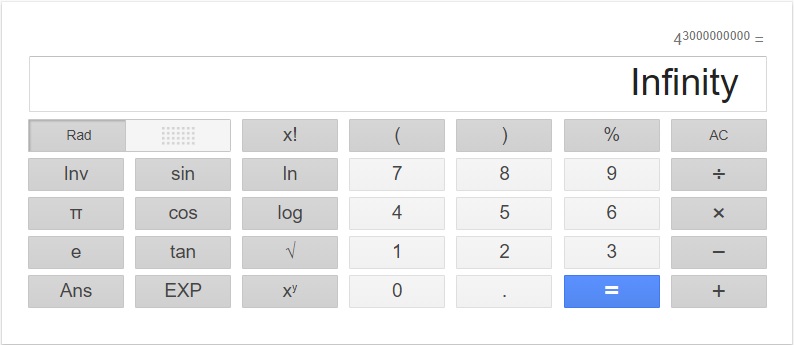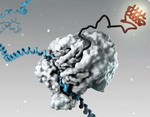The Physics of Life - main assumptions
Some maths Interesting data Evolution 2.0
Some maths 
Comparing the genome to computer data storage: 
It is estimated [Source] that, there are about 3 000 000 000 base pairs in human DNA. With four nitrogen bases at disposal, let's consider how many chains of this length can be created. It will be four to the power of three billion:
43 000 000 000
This is a large number, isn't it? If we try to use a normal calculator there will be an error message:

The number is indeed unimaginably great. To calculate it we have to use this formula:
4x=10xlog4
The result is:
101 806 179 973
Now lets consider how many bacteria would be created from one bacterium when it multiplies once per day over 4.5 bilion years120? So on the first day there are 2, the second 4, the third 8 and so on. The formula is known to most schoolchildren: on the n'th day their number should be two to the power of n.
2n
After 1 642 500 000 000 days (4.5 billion times 365) how many bacteria should there be? The answer121 is mind-blowing:10500 000 000 000! And this is only an estimation. In reality, in favourable conditions, bacteria can replicate up to seventy times per day. So in nature, an object such as a specific (deoxy) ribonucleotide chain had 10500 000 000 000 trials to be built. These simple calculations are based on the assumption of absolute randomness, and yet evolution has a booster122 in the form of natural selection, powered by a strong selection function. To realise how quickly this booster is trigerred, let's run other calculations:
The weight of the average bacterium is estimated to be at about 1*10-12 of a gramme, and the mass of the Earth at 6*1027 grammes. Calculations show that only 133 divisions from a single bacterium are sufficient to make one colony of its descendants to exceed the mass of the Earth! Of course, this is not possible, because there are not enough resources on Earth, but imagine that we have a super-nutrient about the size of Lake Baikal. In this case the struggle for resources will start after 100 divisions. The bacteria will then compete against their siblings for what is left. Assuming that they doubled every twenty minutes, the real battle between them, and thus forming a strong selection function, would be in less than two days!
120 Replication of the elements within the cell runs a lot faster: DNA replication proceeds at a speed of one thousand nucleotides per second! Therefore, assuming that the rate of replication is, for example, one second, from one single replicator, after two days there would be 1052016 copies. However the fastest cellular organisms, in favorable conditions, reproduce approximately every 20-25 minutes.
121 This cannot be obtained using a normal (nor windows scientific) calculator. The trick is to use this formula: 2x = 10xlog2, where x is the number of days in a year multiplied by the age of the Earth, or 365 * 4.5 billion years.
122 Booster (rocketry), used in space flight to provide or augment the main thrust. I think that defining the characteristics of an evolutionary booster is a good topic for science in general.
Interesting data 
3.72×1013 "Annals of Human Biology" - 2013 [Source: https://handling-solutions.eppendorf.com/cell-handling/about-cells-and-culture/detailview/news/how-many-cells-are-in-your-body-probably-more-than-you-think/]
Our bodies are a universe of 37.2 trillion cells operating in more or less perfect concert more or less all the time.
"The body" Bill Bryson
How many divisions does a human cell undergo?:

A typical human cell divides 50 to 70 times from the moment it is formed in the fetus and then undergoes apoptosis.
[Source: Hayflick limit]
The DNA diameter is estimated at 3·10-9m
[Source: Helix_geometries]
The DNA length is estimated at 3 m
[Source: https://hypertextbook.com/facts/1998/StevenChen.shtml]
Number of ribosomes in a human cell: 
up to 106
[Source: "www.sciencemag.org" - 2021]

[Source]
The number of atoms in a person: 
Altogether it takes 7 billion billion billion (that’s 7,000,000,000,000,000,000,000,000,000, or 7 octillion) atoms to make you. No one can say why those 7 billion billion billion have such an urgent desire to be you. They are mindless particles, after all, without a single thought or notion between them. Yet somehow for the length of your existence, they will build and maintain all the countless systems and structures necessary to keep you humming, to make you you, to give you form and shape and let you enjoy the rare and supremely agreeable condition known as life.
"The body" Bill Bryson
Tak więc szacowana liczba atomów w człowieku wynosi:
1027
[Source: https://www.thermofisher.com/pl/en/home/references/ambion-tech-support/rna-isolation/general-articles/ribosomal-rna-sizes.html]
Tak więc szacowany ładunek informacyjny rybosomowego RNA:
Od 1.4 do 4.1 kb
Speed and precision of dna replication: 
700-1000 base pairs per second
1 error on 109 base pairs
[Source: https://www.khanacademy.org/science/ap-biology/gene-expression-and-regulation/replication/v/speed-and-precision-of-dna-replication]
N
Evolution 2.0 
★ Darwin's original full book title was, after all, "On the Origin of Species by Means of Natural Selection, or the Preservation of Favoured Races in the Struggle for Life". In it Darwin wrote: The civilised races of man will almost certainly exterminate, and replace, the savage races throughout the world [108].
I always quote the full title of Darwin's opus magnum too. For two reasons. The first one is to show that he did not mention cooperation. He didn't take into consideration what the Russians wrote ("cooperation" prevail "struggle"). So he understood the world in a reductionist way of thinking. He didn't see as well as his followers, that evolution can operate in two orthogonal directions: struggle and cooperation.
The second is his statement that The civilised races of man will almost certainly exterminate, and replace, the savage races. I visited Tierra del Fuego, it was a dream of mine. I was really upset that there was only one full-blooded Yaghan woman who had survived (she was alive in 2017). Yaghan and Ona tribes were exterminanted, as were the Yotvingians and many other ethnic groups. Does it prove that Darwin was right? Not at all. We cannot draw such reductionist conclusions. John Glubb, in his "Fate of Empires", stated that the rich (civilised?) societies fall through six stages to reach decadence. Then they are invaded by the less civilised, but highly motivated, savages. This lead me to the conclusion that the reductionist model of struggle is not suitable and I created the model of Life Fights. Only the analysis of this model carried out on a computer simulation can draw the right conclusions.
★ In his later book, "The Descent of Man, and Selection in Relation to Sex", remarking on social institutions that care for the poor, Darwin wrote: Excepting in the case of man himself, hardly any one is so ignorant as to allow his worst animals to breed (109). Racism, eugenics and genocide are totally logical if Darwin's understanding of humans is correct…
I would not draw such radical conclusions. You cannot deny that racism and genocide have not occured. In my life I have witnessed the supremacy of "soviet scientists", who were always right. Nowadays, in Poland, we do not even consider eastern scientists, we are blindly looking at mainly American achievements. Germans killed Jews, who are now killing Palestinians. Germans invaded Poland and Russia looking for "living space", Israelis are gradually supplanting Palestinians with administrative methods from their patrimony… All these awful things happen. People are easily programmed: Ron Jones proved it by an experiment in Palo Alto. In 1962, he transformed a group of 200 high school students into aggressive fascists within… 5 days. Nowadays people are controlled by mainstream media.
One of the biggest predjudices is that poor means honest and is exploited by the rich. It is not so simple, it is another misconception coming from political correctness or our dream of social equality. George Orwell, my icon of an honest journalist, wrote a splendid book about poverty: "Down and Out in Paris and London".